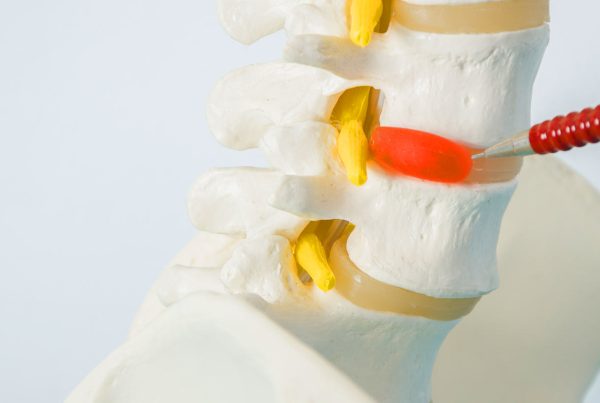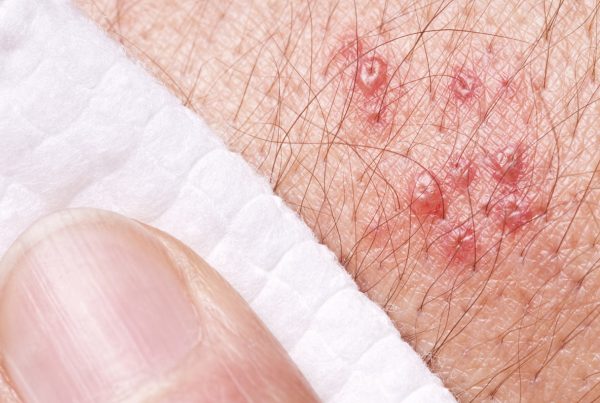Migraine is a primary headache disorder characterized by recurrent headaches that are moderate to severe.[1] Typically, the headaches affect one half of the head, are pulsating in nature, and last from two to 72 hours.[1] Associated symptoms may include nausea, vomiting, and sensitivity to light, sound, or smell.[2] The pain is generally made worse by physical activity.[3] Up to one-third of people have an aura: typically a short period of visual disturbance which signals that the headache will soon occur.[3] Occasionally, an aura can occur with little or no headache following it.[4]
Migraines are believed to be due to a mixture of environmental and genetic factors.[5] About two-thirds of cases run in families.[6] Changing hormone levels may also play a role, as migraines affect slightly more boys than girls before puberty and two to three times more women than men.[7][8] The risk of migraines usually decreases during pregnancy.[7] The underlying mechanisms are not fully known.[9] It is, however, believed to involve the nerves and blood vessels of the brain.[6]
Initial recommended treatment is with simple pain medication such as ibuprofen and paracetamol (acetaminophen) for the headache, medication for the nausea, and the avoidance of triggers.[10] Specific medications such as triptans or ergotamines may be used in those for whom simple pain medications are not effective.[6] Caffeine may be added to the above.[11] A number of medications are useful to prevent attacks including metoprolol, valproate, and topiramate.[12]
Globally, approximately 15% of people are affected by migraines.[13] It most often starts at puberty and is worst during middle age.[1] In some women they become less common following menopause.[9] An early description consistent with migraines is contained in the Ebers papyrus, written around 1500 BCE in ancient Egypt.[14] The word “migraine” is from the Greek ἡμικρανία (hemikrania), “pain on one side of the head”,[15] from ἡμι- (hemi-), “half”, and κρανίον (kranion), “skull”.[16]
Signs and symptoms
Migraines typically present with self-limited, recurrent severe headache associated with autonomic symptoms.[6][17] About 15–30% of people with migraines experience migraines with an aura[10][18] and those who have migraines with aura also frequently have migraines without aura.[19] The severity of the pain, duration of the headache, and frequency of attacks are variable.[6] A migraine lasting longer than 72 hours is termed status migrainosus.[20] There are four possible phases to a migraine, although not all the phases are necessarily experienced:[3]
- The prodrome, which occurs hours or days before the headache
- The aura, which immediately precedes the headache
- The pain phase, also known as headache phase
- The postdrome, the effects experienced following the end of a migraine attack
Prodrome phase
Prodromal or premonitory symptoms occur in about 60% of those with migraines,[2][21] with an onset that can range from two hours to two days before the start of pain or the aura.[22] These symptoms may include a wide variety of phenomena,[23] including altered mood, irritability, depression or euphoria, fatigue, craving for certain food(s), stiff muscles (especially in the neck), constipation or diarrhea, and sensitivity to smells or noise.[21] This may occur in those with either migraine with aura or migraine without aura.[24]
Aura phase
An aura is a transient focal neurological phenomenon that occurs before or during the headache.[2] Auras appear gradually over a number of minutes and generally last less than 60 minutes.[25] Symptoms can be visual, sensory or motor in nature and many people experience more than one.[26] Visual effects occur most frequently; they occur in up to 99% of cases and in more than 50% of cases are not accompanied by sensory or motor effects.[26]
Vision disturbances often consist of a scintillating scotoma (an area of partial alteration in the field of vision which flickers and may interfere with a person’s ability to read or drive).[2] These typically start near the center of vision and then spread out to the sides with zigzagging lines which have been described as looking like fortifications or walls of a castle.[26] Usually the lines are in black and white but some people also see colored lines.[26] Some people lose part of their field of vision known as hemianopsia while others experience blurring.[26]
Sensory aurae are the second most common type; they occur in 30–40% of people with auras.[26] Often a feeling of pins-and-needles begins on one side in the hand and arm and spreads to the nose–mouth area on the same side.[26] Numbness usually occurs after the tingling has passed with a loss of position sense.[26] Other symptoms of the aura phase can include speech or language disturbances,world spinning, and less commonly motor problems.[26] Motor symptoms indicate that this is a hemiplegic migraine, and weakness often lasts longer than one hour unlike other auras.[26] Auditory hallucinations or delusions have also been described.[27]
Pain phase
Classically the headache is unilateral, throbbing, and moderate to severe in intensity.[25] It usually comes on gradually[25] and is aggravated by physical activity.[3] In more than 40% of cases, however, the pain may be bilateral and neck pain is commonly associated with it.[28] Bilateral pain is particularly common in those who have migraines without an aura.[2] Less commonly pain may occur primarily in the back or top of the head.[2] The pain usually lasts 4 to 72 hours in adults,[25] however in young children frequently lasts less than 1 hour.[29] The frequency of attacks is variable, from a few in a lifetime to several a week, with the average being about one a month.[30][31]
The pain is frequently accompanied by nausea, vomiting, sensitivity to light, sensitivity to sound, sensitivity to smells, fatigue and irritability.[2] In a basilar migraine, a migraine with neurological symptoms related to the brain stem or with neurological symptoms on both sides of the body,[32] common effects include a sense of the world spinning, light-headedness, and confusion.[2] Nausea occurs in almost 90% of people, and vomiting occurs in about one-third.[33] Many thus seek a dark and quiet room.[33] Other symptoms may include blurred vision, nasal stuffiness, diarrhea, frequent urination, pallor, or sweating.[34] Swelling or tenderness of the scalp may occur as can neck stiffness.[34] Associated symptoms are less common in the elderly.[35]
Rarely, an aura occurs without a subsequent headache.[26] This is known as an acephalgic migraine or silent migraine; however, it is difficult to assess the frequency of such cases because people who do not experience symptoms severe enough to seek treatment may not realize that anything unusual is happening to them and pass it off without reporting any problems.
Postdrome
The migraine postdrome could be defined as that constellation of symptoms occurring once the acute headache has settled.[36] Many report a sore feeling in the area where the migraine was, and some report impaired thinking for a few days after the headache has passed. The person may feel tired or “hung over” and have head pain, cognitive difficulties, gastrointestinal symptoms, mood changes, and weakness.[37] According to one summary, “Some people feel unusually refreshed or euphoric after an attack, whereas others note depression and malaise.”[38] For some individuals this can vary each time.
Cause
The underlying causes of migraines are unknown.[39] However, they are believed to be related to a mix of environmental and genetic factors.[5] They run in families in about two-thirds of cases[6] and rarely occur due to a single gene defect.[40] While migraines were once believed to be more common in those of high intelligence, this does not appear to be true.[41] A number of psychological conditions are associated, including depression, anxiety, and bipolar disorder,[42] as are many biological events or triggers.
Genetics
Studies of twins indicate a 34% to 51% genetic influence of likelihood to develop migraine headaches.[5] This genetic relationship is stronger for migraines with aura than for migraines without aura.[19] A number of specific variants of genes increase the risk by a small to moderate amount.[40]
Single gene disorders that result in migraines are rare.[40] One of these is known as familial hemiplegic migraine, a type of migraine with aura, which is inherited in an autosomal dominant fashion.[43][44] Four genes have been shown to be involved in familial hemiplegic migraine.[45] Three of these genes are involved in ion transport.[45] The fourth is an axonal protein associated with the exocytosis complex.[45] Another genetic disorder associated with migraine is CADASIL syndrome or cerebral autosomal dominant arteriopathy with subcortical infarcts and leukoencephalopathy.[2]
Triggers
Migraines may be induced by triggers, with some reporting it as an influence in a minority of cases[6] and others the majority.[46] Many things have been labeled as triggers, however the strength and significance of these relationships are uncertain.[46][47] Most people with migraines report to experience triggers.[48] A trigger may be encountered up to 24 hours prior to the onset of symptoms.[6]
Physiological aspects
Common triggers quoted are stress, hunger, and fatigue (these equally contribute to tension headaches).[46] Psychological stress has been reported as a factor by 50 to 80% of people.[49] Migraines have also been associated with post-traumatic stress disorder and abuse.[50] Migraines are more likely to occur around menstruation.[49] Other hormonal influences, such as menarche, oral contraceptive use, pregnancy, perimenopause, and menopause, also play a role.[51] These hormonal influences seem to play a greater role in migraine without aura.[41] Migraines typically do not occur during the second and third trimesters or following menopause.[2]
Dietary aspects
Between 12 and 60% of people report foods as triggers.[52] Evidence for dietary triggers, however, mostly relies on self-reports and is not rigorous enough to prove or disprove any particular triggers.[53][54] A clear explanation for why food might trigger migraines is also lacking.[52]
Regarding specific agents there does not appear to be evidence for an effect of tyramine on migraine,[55] and while monosodium glutamate (MSG) is frequently reported as a dietary trigger,[56] evidence does not consistently support this.[57]
Environmental aspects
A review on potential triggers in the indoor and outdoor environment concluded that there is insufficient evidence to confirm environmental factors as causing migraines. They nevertheless suggested that people with migraines take some preventive measures related to indoor air quality and lighting.[58]
Pathophysiology
Migraines are believed to be a neurovascular disorder[6] with evidence supporting its mechanisms starting within the brain and then spreading to the blood vessels.[59] Some researchers believe neuronal mechanisms play a greater role,[60] while others believe blood vessels play the key role.[61] Others believe both are likely important.[62] One theory is related to increased excitability of the cerebral cortex and abnormal control of painneurons in the trigeminal nucleus of the brainstem.[63] High levels of the neurotransmitter serotonin, also known as 5-hydroxytryptamine, are believed to be involved.[59]
Aura
Cortical spreading depression, or spreading depression according to Leão, is bursts of neuronal activity followed by a period of inactivity, which is seen in those with migraines with an aura.[64] There are a number of explanations for its occurrence including activation of NMDA receptors leading to calcium entering the cell.[64] After the burst of activity the blood flow to the cerebral cortex in the area affected is decreased for two to six hours.[64] It is believed that when depolarization travels down the underside of the brain, nerves that sense pain in the head and neck are triggered.[64]
Pain
The exact mechanism of the head pain which occurs during a migraine is unknown.[65] Some evidence supports a primary role for central nervous system structures (such as the brainstem and diencephalon)[66] while other data support the role of peripheral activation (such as via the sensory nerves that surround blood vessels of the head and neck).[65] The potential candidate vessels include dural arteries, pial arteries and extracranial arteries such as those of the scalp.[65] The role of vasodilatation of the extracranial arteries, in particular, is believed to be significant.[67]
Diagnosis
The diagnosis of a migraine is based on signs and symptoms.[6] Neuroimaging tests are not necessary to diagnose migraine, but may be used to find other causes of headaches in those whose examination and history do not confirm a migraine diagnosis.[68] It is believed that a substantial number of people with the condition remain undiagnosed.[6]
The diagnosis of migraine without aura, according to the International Headache Society, can be made according to the following criteria, the “5, 4, 3, 2, 1 criteria”:[3]
- Five or more attacks—for migraine with aura, two attacks are sufficient for diagnosis.
- Four hours to three days in duration
- Two or more of the following:
- Unilateral (affecting half the head);
- Pulsating;
- Moderate or severe pain intensity;
- Worsened by or causing avoidance of routine physical activity
- One or more of the following:
- Nausea and/or vomiting;
- Sensitivity to both light (photophobia) and sound (phonophobia)
If someone experiences two of the following: photophobia, nausea, or inability to work or study for a day, the diagnosis is more likely.[69] In those with four out of five of the following: pulsating headache, duration of 4–72 hours, pain on one side of the head, nausea, or symptoms that interfere with the person’s life, the probability that this is a migraine is 92%.[10] In those with fewer than three of these symptoms the probability is 17%.[10]
Classification
Migraines were first comprehensively classified in 1988.[19] The International Headache Society most recently updated their classification of headaches in 2004.[3] According to this classification migraines are primary headaches along with tension-type headaches and cluster headaches, among others.[70]
Migraines are divided into seven subclasses (some of which include further subdivisions):
- Migraine without aura, or “common migraine”, involves migraine headaches that are not accompanied by an aura.
- Migraine with aura, or “classic migraine”, usually involves migraine headaches accompanied by an aura. Less commonly, an aura can occur without a headache, or with a nonmigraine headache. Two other varieties are familial hemiplegic migraine andsporadic hemiplegic migraine, in which a person has migraines with aura and with accompanying motor weakness. If a close relative has had the same condition, it is called “familial”, otherwise it is called “sporadic”. Another variety is basilar-type migraine, where a headache and aura are accompanied by difficulty speaking, world spinning, ringing in ears, or a number of other brainstem-related symptoms, but not motor weakness. This type was initially believed to be due to spasms of the basilar artery, the artery that supplies the brainstem.[32]
- Childhood periodic syndromes that are commonly precursors of migraine include cyclical vomiting (occasional intense periods of vomiting), abdominal migraine (abdominal pain, usually accompanied by nausea), and benign paroxysmal vertigo of childhood (occasional attacks of vertigo).
- Retinal migraine involves migraine headaches accompanied by visual disturbances or even temporary blindness in one eye.
- Complications of migraine describe migraine headaches and/or auras that are unusually long or unusually frequent, or associated with a seizure or brain lesion.
- Probable migraine describes conditions that have some characteristics of migraines, but where there is not enough evidence to diagnose it as a migraine with certainty (in the presence of concurrent medication overuse).
- Chronic migraine is a complication of migraines, and is a headache that fulfills diagnostic criteria for migraine headache and occurs for a greater time interval. Specifically, greater or equal to 15 days/month for longer than 3 months.[71]
Abdominal migraine
The diagnosis of abdominal migraines is controversial.[72] Some evidence indicates that recurrent episodes of abdominal pain in the absence of a headache may be a type of migraine[72][73] or are at least a precursor to migraines.[19] These episodes of pain may or may not follow a migraine-like prodrome and typically last minutes to hours.[72] They often occur in those with either a personal or family history of typical migraines.[72] Other syndromes that are believed to be precursors include cyclical vomiting syndrome and benign paroxysmal vertigo of childhood.[19]
Differential diagnosis
Other conditions that can cause similar symptoms to a migraine headache include temporal arteritis, cluster headaches, acute glaucoma, meningitis and subarachnoid hemorrhage.[10] Temporal arteritis typically occurs in people over 50 years old and presents with tenderness over the temple, cluster headaches presents with one-sided nose stuffiness, tears and severe pain around the orbits, acute glaucoma is associated with vision problems, meningitis with fevers, and subarachnoid hemorrhage with a very fast onset.[10] Tension headaches typically occur on both sides, are not pounding, and are less disabling.[10]
Those with stable headaches which meet criteria for migraines should not receive neuroimaging to look for other intracranial disease.[74][75][76] This requires that other concerning findings such as papilledema (swelling of the optic disc) are not present. People with migraines are not at an increased risk of having another cause for severe headaches.
Prevention
Preventive treatments of migraines include medications, nutritional supplements, lifestyle alterations, and surgery. Prevention is recommended in those who have headaches more than two days a week, cannot tolerate the medications used to treat acute attacks, or those with severe attacks that are not easily controlled.[10]
The goal is to reduce the frequency, painfulness, and/or duration of migraines, and to increase the effectiveness of abortive therapy.[77] Another reason for prevention is to avoid medication overuse headache. This is a common problem and can result in chronic daily headache.[78][79]
Medication
Preventive migraine medications are considered effective if they reduce the frequency or severity of the migraine attacks by at least 50%.[80] Guidelines are fairly consistent in rating topiramate, divalproex/sodium valproate, propranolol, and metoprolol as having the highest level of evidence for first-line use.[81] Recommendations regarding effectiveness varied however for gabapentin.[81] Timolol is also effective for migraine prevention and in reducing migraine attack frequency and severity, while frovatriptan is effective for prevention of menstrual migraine.[81]
Amitriptyline and venlafaxine are probably also effective.[82] Angiotensin inhibition by either an angiotensin-converting enzyme inhibitor or angiotensin II receptor antagonist may reduce attacks.[83] Botulinum toxin (Botox) has been found to be useful in those with chronic migraines but not those with episodic ones.[84][85]
Alternative therapies
While acupuncture may be effective, “true” acupuncture is not more efficient than sham acupuncture, a practice where needles are placed randomly.[87] Both have a possibility of being more effective than routine care, with fewer adverse effects than preventative medications.[87] Chiropractic manipulation, physiotherapy, massage and relaxation might be as effective as propranolol or topiramate in the prevention of migraine headaches; however, the research had some problems with methodology.[88] The evidence to support spinal manipulation is poor and insufficient to support its use.[89]Tentative evidence supports the use of stress reduction techniques such as cognitive behavioral therapy, biofeedback, and relaxation techniques.[49] Of the alternative medicines, butterbur has the best evidence for its use.[90]
Devices and surgery
Medical devices, such as biofeedback and neurostimulators, have some advantages in migraine prevention, mainly when common anti-migraine medications are contraindicated or in case of medication overuse. Biofeedback helps people be conscious of some physiological parameters so as to control them and try to relax and may be efficient for migraine treatment.[91][92] Neurostimulation uses implantable neurostimulators similar to pacemakers for the treatment of intractable chronic migraines with encouraging results for severe cases.[93][94] A transcutaneous electrical nerve stimulation device is approved in the United States for the prevention of migraines.[95] Migraine surgery, which involves decompression of certain nerves around the head and neck, may be an option in certain people who do not improve with medications.[96]
Article By Wikipedia



